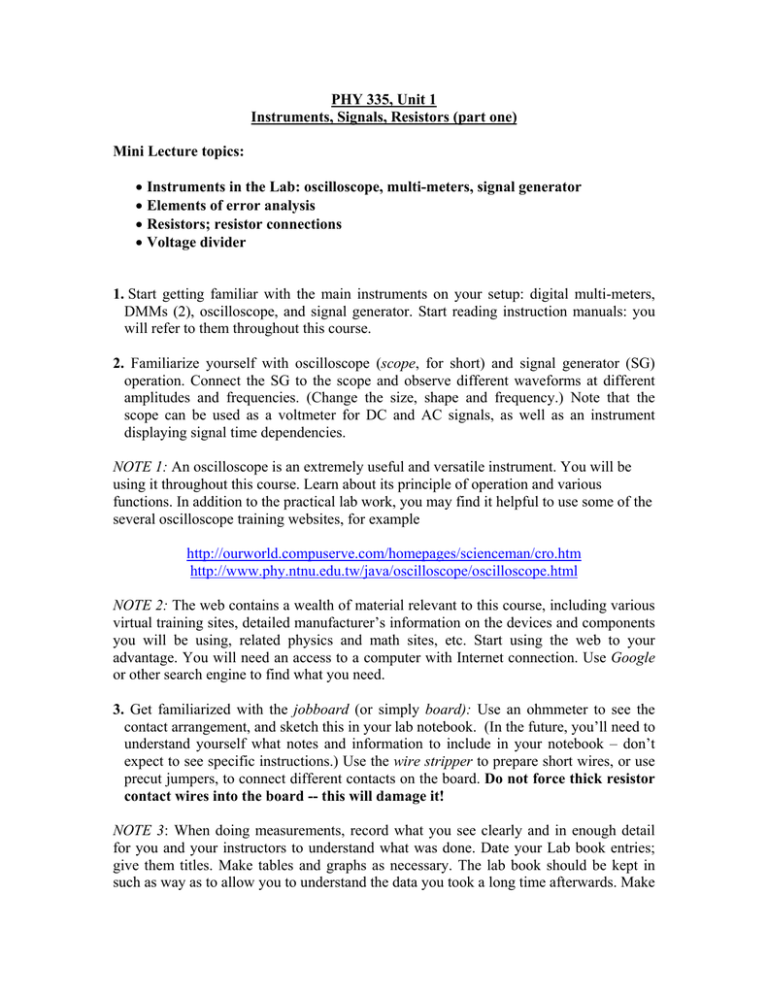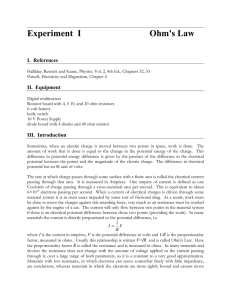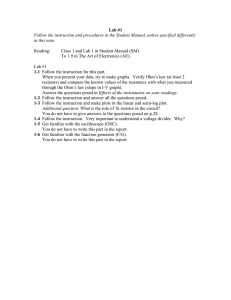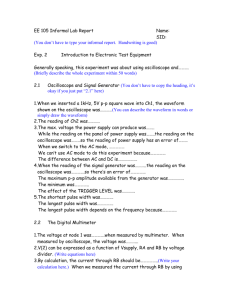PHY 335, Unit 1 Instruments, Signals, Resistors (part one) Mini
advertisement

PHY 335, Unit 1 Instruments, Signals, Resistors (part one) Mini Lecture topics: • Instruments in the Lab: oscilloscope, multi-meters, signal generator • Elements of error analysis • Resistors; resistor connections • Voltage divider 1. Start getting familiar with the main instruments on your setup: digital multi-meters, DMMs (2), oscilloscope, and signal generator. Start reading instruction manuals: you will refer to them throughout this course. 2. Familiarize yourself with oscilloscope (scope, for short) and signal generator (SG) operation. Connect the SG to the scope and observe different waveforms at different amplitudes and frequencies. (Change the size, shape and frequency.) Note that the scope can be used as a voltmeter for DC and AC signals, as well as an instrument displaying signal time dependencies. NOTE 1: An oscilloscope is an extremely useful and versatile instrument. You will be using it throughout this course. Learn about its principle of operation and various functions. In addition to the practical lab work, you may find it helpful to use some of the several oscilloscope training websites, for example http://ourworld.compuserve.com/homepages/scienceman/cro.htm http://www.phy.ntnu.edu.tw/java/oscilloscope/oscilloscope.html NOTE 2: The web contains a wealth of material relevant to this course, including various virtual training sites, detailed manufacturer’s information on the devices and components you will be using, related physics and math sites, etc. Start using the web to your advantage. You will need an access to a computer with Internet connection. Use Google or other search engine to find what you need. 3. Get familiarized with the jobboard (or simply board): Use an ohmmeter to see the contact arrangement, and sketch this in your lab notebook. (In the future, you’ll need to understand yourself what notes and information to include in your notebook – don’t expect to see specific instructions.) Use the wire stripper to prepare short wires, or use precut jumpers, to connect different contacts on the board. Do not force thick resistor contact wires into the board -- this will damage it! NOTE 3: When doing measurements, record what you see clearly and in enough detail for you and your instructors to understand what was done. Date your Lab book entries; give them titles. Make tables and graphs as necessary. The lab book should be kept in such as way as to allow you to understand the data you took a long time afterwards. Make special notes of anything unusual / interesting / unexpected, and always try to explain what you see. 4. Turn on the DC power supply, and, using a DC voltmeter, check voltages on the board using the DMM. Check that same voltage level using an oscilloscope and try to determine the uncertainty of this measurement (the uncertainty may originate from voltage fluctuations and/or from the reading of the voltage level on the scope screen (trace thickness, etc). Record the readings and the estimated uncertainty. 5. Learn to use resistor bar code to read resistor values. Make a copy of a bar code in your lab book. Plug into the board three resistors of different nominal value (for example, 100 ohm, 1k, 5k, or other resistors) and measure their real values in the board, first individually (note % error compared to the nominal), then in series and in parallel, and finally in series-parallel connections. Compare the measured values with the calculation [use the measured individual values for the calculation; draw the connection diagram (the circuit) and show the calculation]. Repeatedly re-insert resistors into the board to see how contact resistance affects your measurement uncertainty, if at all, and report error in your measurements. 6. Find out from the multimeter instruction manual what current is passed through the resistor when you are using the multimeter as an ohmmeter. Understand the principle of a resistance measurement. 7. Recall the Ohm’s Law theoretical basis. Explain the difference between the resistance and resistivity. 8. Use the signal generator to apply linearly rising and falling (triangular) voltage to a resistor. Make your scope display the triangular wave first, and record it in your lab book. Then make your scope display the current-voltage (I-V) characteristic across the resistor, with current on the Y axis and voltage on the X axis. The linear I-V you will find is called an ohmic I-V. Find the resistance from that I-V for three different resistors. Confirm the resistance values using the ohmmeter.








